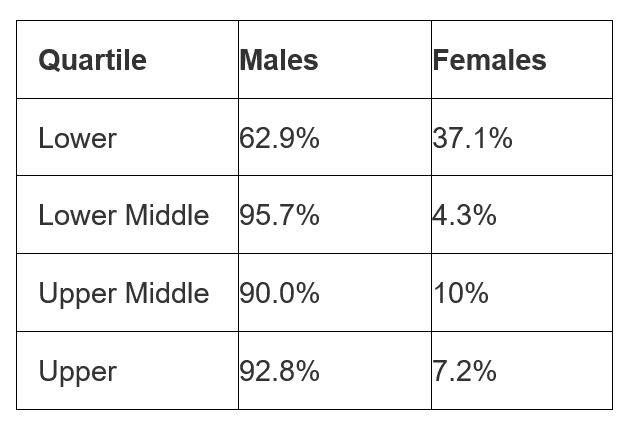Gender Pay Gap Report 2021
Foreword
Terminix UK recognises that gender along with all other forms of diversity, creates a strong and sustainable business, and our goal remains to be an employer of choice.
At the time of reporting as operational roles account for the majority of our workforce and there is the highest proportion of males in these roles, our median gender pay gap has increased this year to 27%, above the UK national median gender pay gap of 15.4% (according to the October 2021 Office for National Statistics (ONS) Gender Pay Gap in the UK:2021).
Our Gender Pay Gap
This is our annual gender pay gap report for the snapshot date of 5 April 2021.
- Our mean gender pay gap is 23%
- Our median gender pay gap is 27%
- Our mean gender bonus gap is -12%
- Our median gender bonus gap is -14.9%
- The proportion of male employees receiving a bonus is 80.2%, whereas the proportion of female employees receiving a bonus is 36.6%
Pay quartiles by gender
This table shows our workforce divided into four equal-sized groups based on hourly pay rate. The Lower quartile includes the lowest paid 25% of employees and the Upper quartile covers the highest paid 25%.

37.1% of the employees in the lower quartile are women and 62.9% men. The percentage of male employees increases throughout the remaining bands, to 90% or more in each quartile, with 92.8% male employees in the upper quartile.
We are confident that our gender pay gap is not because we pay men and women differently for the same or equivalent work. Instead, our gender pay gap is because men and women work in different roles and those roles have different salaries.
71% of our total female workforce are in roles in the lowest two quartiles, 63% in the lowest quartile and 7% in the lower middle. In the highest paid quartile, 7.2% are female equating to 12% of our total female workforce.
In the 12 months up to 5 April 2021, 80.2 % of men and 36.6% of women in our organisation received a bonus, both down on last year.
Our mean and median gender bonus gaps are negative percentage figures as overall employees who are men received lower bonus then employees who are women in our organisation. During 2020/21 the organisation saw a decline in work from some customers and increased absence due to covid restrictions and sickness. This negatively impacting the bonus and commission eligibility and earnings, particularly for field based operational roles which are held by more men in the workplace. This together with a one off bonus was also made during this period to support roles which are predominately held by female employees impacted the gender bonus gaps for this period between men and women.
What are we doing to address our gender pay gap?
The main reason for the gap remains that there is not an equal ratio of men to women in each quartile of our organisation, and there is a lower proportion of women in middle management and senior roles, which receive the highest pay, relative to men.
Though the make up of our organisation is reflective of UK economy as a whole and our sector. We remain committed to addressing the imbalance of men and women throughout our organisation and the challenge of attracting more women into the Operational Pest Control sector.
So far, we have taken the following steps to promote gender diversity:
Increased the number of women in operational roles, building female representation in our front-line Pest Control roles and in turn creating a pipeline of women for middle and senior manager roles going forward.
Revised our flexible working policy for all employees; and
Reviewed our policy on bonus payments and our employee reward proposition.
By themselves, none of these initiatives will remove the gender pay gap and it may take time for a real impact to be seen, however we will continue to monitor and report on what we’re doing to reduce the gender pay gap.
James Gilding
Managing Director
April 2022
